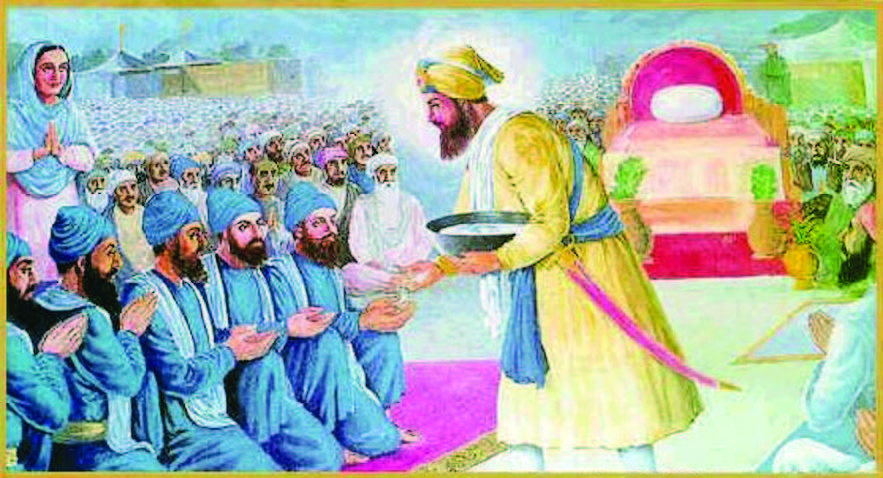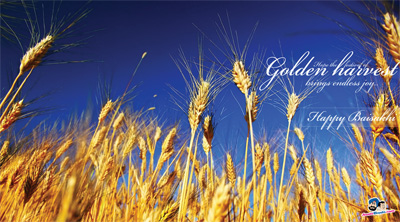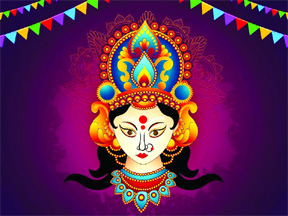
IT was the Baisakhi day, March 30,1699. A large gathering of peasants was waiting anxiously. A strange excitement permeated the air. Something was going to happen. Something that would have an everlasting impact on Indian history. And it would have its genesis in Makhowal, a small hamlet on the banks of the Sutlej.
As the farmers waited with bated breath, Shri Guru Gobind Singh ji, the Tenth Guru, appeared holding a naked sword in his hand. He raised his sword and demanded a head from one of his followers. A hush fell over the gathering. No one demurred. The Guru repeated his words. On hearing his demand for the third time, one Daya Ram of Lahore stepped forward and said: “My head is at your service, my Lord”, The Guru took the disciple into a nearby tent and soon returned. His sword was now dripping with blood. He raised his authoritative voice and demanded yet another head. Far from being daunted by the thought of death, another disciple, Dharam Das of Delhi, volunteered to sacrifice himself for his Guru. In the events that followed Guru Gobind Singh made three more such calls and consequently Mohkam Chand of Dwarka, Himmat of Jagannath, and Sahib Chand of Bidar came forward and offered their heads.
The Guru was obviously testing his disciples and was not really interested in human sacrifice. He was so pleased by the devotion of these five followers that he called them the Five Beloved ones or the Panj Piyaras. One of them was a Khatri and the rest Shudras. As the Guru did not believe in caste system, he baptised all of them and announced the birth of the Khalsa. He addressed the dumbstruck crowd thus: “In the time of Guru Nanak, there was just one devout Sikh, Guru Angad; now there are five – totally devoted to their Guru. These shall lay the foundation of Sikhism”.
It was a very dark period in Indian history. Aurangzeb’s persecution of non-Muslims was at its peak. In his essay Birth of Khalsa, Dr Hari Ram Gupta writes:
“Aurangzeb had decided to use all the resources of a vast empire in suppressing Hinduism and converting the infidels to Islam…. In 1668 Hindu fairs and festivals were stopped. On April 9, 1669, a general order applicable to all parts of the Mughal Empire was issued to demolish all the schools and temples of the infidels and to put down their religious teachings”. In January, 1670, the biggest temple of Keshav Rae at Mathura was destroyed and the city was named Islamabad… . Hindus employed in public service, including clerks and accountants, were dismissed in 1671. The post of qanungo could be retained by a Hindu embracing Islam. Others who became Muslims received stipends, rewards, government jobs, release from jails, right to ancestral property and other privileges… . Jazia was charged from all Hindus from April 2, 1679″.
Guru Gobind Singh was extremely disturbed by all this. Voluntary conversion to another religion is one thing; forcible conversion quite another. The Guru and his family were themselves among the worst sufferers. His father, Guru Tegh Bahadur, had been beheaded on November 11, 1675, by Aurangzeb. Hinduism in those days had become too ritualistic and dogmatic and the Hindus were, according to Dr Gokal Chand Narang, “too mild by nature, too contented in their desires, too modest in their aspirations, too averse to physical exertion and terror-stricken and demoralized, even though strongly attached to their religion. They had religion but no national feeling. Guru Gobind Singh sought to make nationalism their religion”. The Guru’s aim was Chiriaan kolon baaz marawaan; Taan main Gobind naam kahaawaan (Call me by the name of Gobind only if I succeed in making sparrows kill hawks).
Earlier, it was a custom to drink the water with which the Gurus washed their feet, but as Guru Gobind Singh wanted to instil martial spirit in his followers, and thus change them from Sikhs to Singhs (lions), he proposed to baptise them by water stirred with a khanda (sword). To strike a blow against the class-ridden society, he urged all his followers to attach ‘Singh’ to their first names irrespective of their caste or creed. He also asked them to always have on their person Kesh, Kangha, Karha, Kaccha and Kirpan (long hair, a comb, a steel bracelet, a vest, and sword). His followers were to celebrate Holi by conducting martial arts, sport, military parades and mock battles. He later baptised about 20,000 disciples and named the place Shri Anandpur Sahib, the city of bliss.
J.D. Cunningham writes in History of the Sikhs: “A new faith had been declared, and henceforth the Khalsa, the saved or liberated, should alone prevail. God must be worshipped in truthfulness and sincerity, but no material resemblance must degrade the Omnipotent; the Lord could only be beheld by the eye of faith in the general body of the Khalsa”.
But the Guru was not only a great warrior. He was a great saint, poet, scholar and philosopher too. He had mastered Sanskrit, Gurmukhi and Persian texts. Under his directions major Sanskrit and Persian works were translated into the vernacular language so that the common man could benefit from them. Towards this end he employed 52 poets and scholars. In A History of the Sikh People, Dr Gopal Singh observes: “In Riti Kavya, or traditional poetry, the Guru’s poetry is unexcelled in the sweep of imagination, choice of word and phrase, and mastery over metre. There is no metre known to Indian prosody that has not been employed by this Great Master (he experimented with over 250 metres), nor a mood that he has not captured”.
There are so many historical places associated with Guru Gobind Singh, but Shri Anandpur Sahib has a special significance. The city has had a very turbulent past, and because of its historical and spiritual status, it is one of the five most important places of worship of the Sikhs. The holy city was actually founded by Guru Tegh Bahadur in 1664. Its older name was Makhowal and Guru Tegh Bahadur had bought it from the then ruler of Bilaspur.
The city is dotted with historical gurdwaras and forts. Gurdwara Kesgarh Sahib, Gurdwara Sis Ganj Sahib, Gurdwara Lohgarh Sahib, Gurdwara Fatehgarh Sahib, Gurdwara Bhora Sahib and Fort Anandgarh are the prominent ones.
Gurdwara Kesgarh Sahib is clearly the most important gurdwara at Anandpur Sahib. It is one of the five important Takhts (seats) of the Sikh religion. The Khanda or the double-edged sword with which Guru Gobind Singh stirred the holy water in 1669 can be seen in this gurdwara. It also houses five other arms associated with the Tenth Guru – Katar, the dagger used by the Guru for hand-to-hand-fights and for hunting; the Karpa Barchha, spear; the Nagin Barchha, spear with a snake-shaped blade; and a musket.
After the martyrdom of Guru Tegh Bahadur, Guru Gobind Singh began to plan his strategy at Gurdwara Fatehgarh Sahib. But before tackling the Mughal forces he had to reckon with Raja Bhim Chand of Bilaspur who had sent a force under Raja Kesari Chand to attack Anandpur Sahib. The Guru organised a battalion and ordered Bhai Uday Singh to get ready for battle. Bhai Uday Singh beheaded Kesari Chand and offered his head to the Guru. Guru Gobind Singh was very proud of his victorious army, so he built a fort at the spot and called it Fatehgarh Sahib.
Gurdwara Guru ka Mahal was the residence of Guru Tegh Bahadur, and it was here that the sons of Guru Gobind Singh were born. Gurdwara Sis Ganj Sahib is very close to the bus-stand and the head of Guru Tegh Bahadur was cremated here. Shri Guru Tegh Bahadur Museum displays paintings depicting the sacrifices made by the Sikh Gurus.
Anandpur Sahib is thronged by thousands of pilgrims during the month of Holi to celebrate the Hola Mohalla. The brave Khalsas display martial arts as well as horse-riding, sword-fighting and other military sport in front of an enthusiastic crowd. The entire city is then agog with feverish activity and it reminds us of the day 300 years ago when Guru Gobind Singh demanded the heads of his disciples, created the Khalsa, and picked up his sword to protect dharma:
“For this purpose was I born, Bear this in mind all ye saints; To propagate dharma, to protect saints,To annihilate all tyrants.”





Be the first to comment